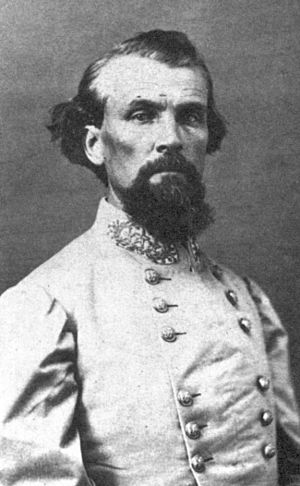Streight's Raid facts for kids
Quick facts for kids Streight's Raid |
|||||||
|---|---|---|---|---|---|---|---|
| Part of American Civil War | |||||||
 Map of locations involved in Streight's Raid |
|||||||
|
|||||||
| Belligerents | |||||||
| Commanders and leaders | |||||||
| Nathan B. Forrest | Abel Streight | ||||||
| Strength | |||||||
| 500 | 1,700 | ||||||
| Casualties and losses | |||||||
| 65 | 1,547 | ||||||
Streight's Raid was an event during the American Civil War that happened in northern Alabama. It took place from April 19 to May 3, 1863. This raid was led by Union Army Colonel Abel Streight. He was trying to stop supplies from reaching the Confederate army.
The Confederates were led by Brigadier General Nathan Bedford Forrest. Streight's plan was to destroy parts of the Western and Atlantic Railroad. This railroad was very important for supplying the Confederate Army of Tennessee. However, the raid was not well-planned or supplied. It ended with Streight and his 1,700 men being defeated. This happened at Cedar Bluff, Alabama. General Forrest, with only 500 men, tricked Streight into surrendering.
Streight's forces also faced problems from local people during their journey. Forrest, on the other hand, knew the area well. He also had help from local people. One famous helper was a young woman named Emma Sansom.
Contents
The Daring Plan
Colonel Abel Streight had a big goal. He wanted to cut off supplies for the Confederate army. His plan was to destroy the railroad tracks. This would stop food, weapons, and other important items from reaching the soldiers.
Streight's group of about 1,700 Union soldiers started their journey. They were supposed to move quickly and cause a lot of damage. But right from the start, they faced challenges. Their supplies were low, and the plan had some weaknesses.
A Tricky Chase
As Streight's men moved through Alabama, General Nathan Bedford Forrest and his Confederate soldiers chased them. Forrest was very good at moving fast. He knew the local area perfectly.
Local people often helped Forrest. They would tell him where Streight's men were. They also helped him find shortcuts. This made it very hard for Streight to get away. One young woman, Emma Sansom, famously helped Forrest cross a river. She showed him a good place to cross, even while under fire.
The Clever Trick
The most surprising part of the raid happened at the end. General Forrest used a very smart trick to capture Streight's much larger force. He made his smaller group of about 500 soldiers look like a huge army.
Forrest had his men march in circles. They would appear from one direction, then quickly ride around and appear from another. This made Streight believe he was surrounded by a much bigger army. Streight thought he had no choice but to surrender.
After Streight surrendered, he learned about Forrest's trick. He was very surprised and reportedly asked for his weapons back to fight properly! Forrest, of course, politely said no.
A Coordinated Effort
Streight's Raid was not the only raid happening at that time. It was planned to work with another, more famous raid. This was Grierson's Raid. Grierson's Raid was happening further west.
The idea was for both raids to confuse the Confederate forces. They hoped to make the Confederates spread out their soldiers. This would make it easier for other Union armies to move.
What Happened Next
The raid ended with a big loss for the Union side. Out of Streight's 1,700 men, 12 were killed and 69 were wounded. A large number, 1,466 soldiers, were captured. This meant a total of 1,547 Union soldiers were lost.
After being captured, Streight and his men were taken as prisoners of war. They were sent to Richmond, Virginia.
Key People
- Colonel Abel Streight: He was the Union officer who led this raid. His goal was to destroy important railroad lines in Alabama. He hoped to cut off supplies for the Confederate army.
- Brigadier General Nathan Bedford Forrest: He was the Confederate general who chased and captured Streight. Forrest was known for his fast movements and clever tactics. He famously tricked Streight into surrendering.
Images for kids





